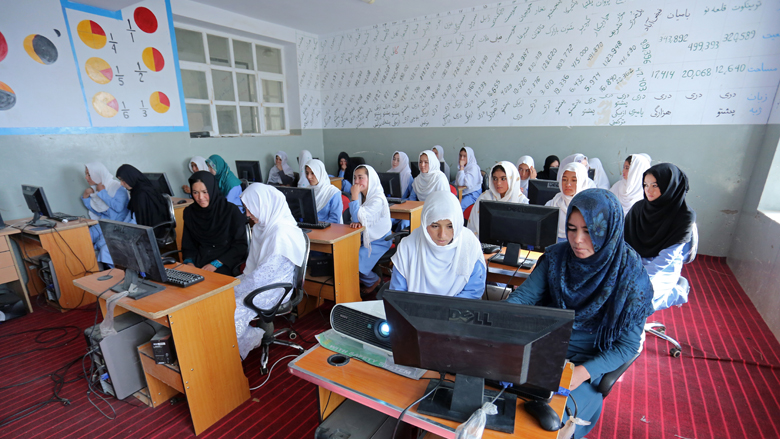From World Bank
Story Highlights
- A village girls’ school in Daykundi Province is raising the quality of education through grants from EQUIP and its own school improvement projects inspired by the program
- Students are more enthusiastic about learning after the school acquired appropriate teaching facilities and materials with help from EQUIP
- EQUIP has built schools, awarded grants for enhancing education quality, and engaged communities through school management councils in all of the province’s districts
” The grants supported by EQUIP provided us with the necessary supplies and the students are happier and more eager to come to school now. “
Kobra Haidari
SANGMOM VILLAGE, Daykundi Province – Dozens of girls in robin egg-blue school uniforms and white headscarves are running around the schoolyard of Zainabia Sanmom Girls High School. A volleyball match between two school teams is going on, and groups of girls sit in the shade of the sturdy school building, cheering on the players. The whitewashed walls of the school are painted with the labeled flags of dozens of countries.
Inside, groups of girls sit at small desks, reading aloud from books as their teacher leads the lesson from the blackboard. In the school’s red-carpeted computer laboratory, girls gather in pairs around solar-powered desktop computers, learning to use them. “When we first came to this building, we had just classrooms and blackboards, that was it,” says Kobra Haidari, the school principal, about Zainabia Sanmom Girls High School.
The school has an enrollment of over 1,000 students from about 400 households in Sangmom village in Daykundi Province in central Afghanistan. It was able to improve its facilities and teaching materials with the help from the Education Quality Improvement Program (EQUIP). EQUIP provided the school an Infrastructure Development Grant (IDG) in 2008 and a Quality Enhancement Grant (QEG) a year later.
Both grants were used to buy computers, laboratory materials, and solar panels, establish a library, dig a well for clean drinking water, and paint the school walls. The school also bought trees and other plants to educate students on the importance of preserving the environment and to green the school grounds.
“The grants provided us with the necessary supplies and the students are happier and more eager to come to school now,” says Kobra Haidari. At the same time, the EQUIP support inspired the school administration and community to start their own school improvement projects, including the creation of volleyball teams, essay competitions, and poetry readings.
As a result, the quality of teaching has improved as teachers are equipped with the appropriate teaching aids and materials to conduct laboratory experiments and other hands-on exercises. “Before, we didn’t have computers and all of our lessons were theoretical,” says Sakina Hussaini, 25, a computer and history teacher at the school. “With the computers, the lessons are going well.”
EQUIP, now in its second phase, seeks to increase equitable access to quality basic education, especially for girls. It is implemented by the Ministry of Education and was first funded by the International Development Association (IDA), the World Bank Group’s fund for the poorest countries. The Afghanistan Reconstruction Trust Fund(ARTF) has taken over funding as co-financier of the project.

In the school’s red-carpeted computer laboratory, girls gather in pairs around solar-powered desktop computers, learning to use the Windows operating system.
Photo Credit: Rumi Consultancy/World Bank
Community engagement raises education quality
In Daykundi Province, EQUIP has constructed schools, awarded QEGs between $2,000 and $5,000 to improve the quality of education at local schools, and engaged the community by establishing School Management Shuras, or councils.
EQUIP programs have been implemented in 350 of the 376 schools in the province. EQUIP has built 63 school buildings across all eight districts of the province since it began work in Daykundi in 2004. “We have worked in Daykundi to provide equal opportunities to both girls and boys in schools,” says Mousa Azad, an EQUIP program officer for Daykundi Province. “The shuras have helped us a lot in this work. The community engagement has improved the quality of our work.”
The shuras have solved problems at the school, including teacher shortages and issues with drinking water. In addition to discussing school issues, the shuras are an opportunity for the community to gather together. “EQUIP has helped us because it created the shura, which is solving all our problems,” says Kobra Haidari. “Students’ parents participate in shura meetings every month and we have solved many problems through the council.”

In Daykundi Province, EQUIP has built 63 school buildings across all eight districts.
Photo Credit: Rumi Consultancy/World Bank
The students are enthusiastic about the improvements the program has brought. “In the past, we didn’t have computer or science laboratories. Our school was just stones,” says Shukria, 17, who is in 12th grade. “Now our area is greener, the school is more interesting, they painted the walls, and we can learn practically and theoretically. Before, I didn’t even know how to turn on a computer, and now I can work with one.”
Raising the quality of education has paid off, with students gaining a good foundational knowledge and being empowered to pursue higher studies. Hania Mohammadi, 17, an 11th grader at the school points out, “Most of the girls who graduated from this school were accepted into universities. Our studies are going well.”
